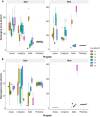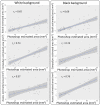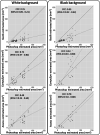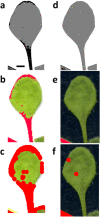Saving time maintaining reliability: a new method for quantification of Tetranychus urticae damage in Arabidopsis whole rosettes
- PMID: 32854637
- PMCID: PMC7450957
- DOI: 10.1186/s12870-020-02584-0
Saving time maintaining reliability: a new method for quantification of Tetranychus urticae damage in Arabidopsis whole rosettes
Abstract
Background: The model species Tetranychus urticae produces important plant injury and economic losses in the field. The current accepted method for the quantification of the spider mite damage in Arabidopsis whole rosettes is time consuming and entails a bottleneck for large-scale studies such as mutant screening or quantitative genetic analyses. Here, we describe an improved version of the existing method by designing an automatic protocol. The accuracy, precision, reproducibility and concordance of the new enhanced approach are validated in two Arabidopsis accessions with opposite damage phenotypes. Results are compared to the currently available manual method.
Results: Image acquisition experiments revealed that the automatic settings plus 10 values of brightness and the black background are the optimal conditions for a specific recognition of spider mite damage by software programs. Among the different tested methods, the Ilastik-Fiji tandem based on machine learning was the best procedure able to quantify the damage maintaining the differential range of damage between accessions. In addition, the Ilastik-Fiji tandem method showed the lowest variability within a set of conditions and the highest stability under different lighting or background surroundings. Bland-Altman concordance results pointed out a negative value for Ilastik-Fiji, which implies a minor estimation of the damage when compared to the manual standard method.
Conclusions: The novel approach using Ilastik and Fiji programs entails a great improvement for the quantification of the specific spider mite damage in Arabidopsis whole rosettes. The automation of the proposed method based on interactive machine learning eliminates the subjectivity and inter-rater-variability of the previous manual protocol. Besides, this method offers a robust tool for time saving and to avoid the damage overestimation observed with other methods.
Keywords: Arabidopsis thaliana; Assess; Chlorotic spots; CompuEye; Fiji; Ilastik; Machine learning; Photoshop; Plant damage quantification; Tetranychus urticae.
Conflict of interest statement
The authors declare that they have no competing interests.
Figures











Similar articles
-
Reciprocal responses in the interaction between Arabidopsis and the cell-content-feeding chelicerate herbivore spider mite.Plant Physiol. 2014 Jan;164(1):384-99. doi: 10.1104/pp.113.231555. Epub 2013 Nov 27. Plant Physiol. 2014. PMID: 24285850 Free PMC article.
-
Tomato Whole Genome Transcriptional Response to Tetranychus urticae Identifies Divergence of Spider Mite-Induced Responses Between Tomato and Arabidopsis.Mol Plant Microbe Interact. 2015 Mar;28(3):343-61. doi: 10.1094/MPMI-09-14-0291-FI. Mol Plant Microbe Interact. 2015. PMID: 25679539
-
Multiple indole glucosinolates and myrosinases defend Arabidopsis against Tetranychus urticae herbivory.Plant Physiol. 2021 Sep 4;187(1):116-132. doi: 10.1093/plphys/kiab247. Plant Physiol. 2021. PMID: 34618148 Free PMC article.
-
Rapid host-plant adaptation in the herbivorous spider mite Tetranychus urticae occurs at low cost.Curr Opin Insect Sci. 2019 Dec;36:82-89. doi: 10.1016/j.cois.2019.08.006. Epub 2019 Aug 19. Curr Opin Insect Sci. 2019. PMID: 31539789 Review.
-
Plant-Herbivore Interactions: A Case of an Extreme Generalist, the Two-Spotted Spider Mite Tetranychus urticae.Mol Plant Microbe Interact. 2017 Dec;30(12):935-945. doi: 10.1094/MPMI-07-17-0168-CR. Epub 2017 Oct 23. Mol Plant Microbe Interact. 2017. PMID: 28857675 Review.
Cited by
-
Spider mite herbivory induces an ABA-driven stomatal defense.Plant Physiol. 2024 Jul 31;195(4):2970-2984. doi: 10.1093/plphys/kiae215. Plant Physiol. 2024. PMID: 38669227 Free PMC article.
-
The RIN4-like/NOI proteins NOI10 and NOI11 modulate the response to biotic stresses mediated by RIN4 in Arabidopsis.Plant Cell Rep. 2024 Feb 15;43(3):70. doi: 10.1007/s00299-024-03151-9. Plant Cell Rep. 2024. PMID: 38358510 Free PMC article.
-
Hydroxynitrile lyase defends Arabidopsis against Tetranychus urticae.Plant Physiol. 2022 Aug 1;189(4):2244-2258. doi: 10.1093/plphys/kiac170. Plant Physiol. 2022. PMID: 35474139 Free PMC article.
-
Opposite roles of MAPKKK17 and MAPKKK21 against Tetranychus urticae in Arabidopsis.Front Plant Sci. 2022 Dec 7;13:1038866. doi: 10.3389/fpls.2022.1038866. eCollection 2022. Front Plant Sci. 2022. PMID: 36570948 Free PMC article.
-
miR825-5p-regulated TNLs govern Arabidopsis resistance to Tetranychus urticae and Pieris brassicae.New Phytol. 2025 Sep;247(6):2927-2944. doi: 10.1111/nph.70411. Epub 2025 Jul 29. New Phytol. 2025. PMID: 40728092 Free PMC article.
References
-
- Luedeling E, Steinmann KP, Zhang M, Brown PH, Grant J, Girvetz EH, et al. Climate change effects on walnut pests in California. Glob Chang Biol. 2011;17:228–238.
-
- Van Leeuwen T, Dermauw W. The molecular evolution of xenobiotic metabolism and resistance in Chelicerate mites. Annu Rev Entomol. 2016;61:475–498. - PubMed
-
- Park YL, Lee JH. Leaf cell and tissue damage of cucumber caused by two spotted spider mite (Acari: Tetranychidae) J Econ Entomol. 2002;95:952–957. - PubMed
-
- Farouk S, Osman MA. The effect of plant defence elicitors on common bean (Phaseolus vulgaris L.) growth and yield in absence or presence of spider mite (Tetranychus urticae Koch) infestation. J Stress Physiol Biochem. 2011;7:5–22.
MeSH terms
LinkOut - more resources
Full Text Sources
Other Literature Sources

